Lockheed Martin F-22 Raptor
The Lockheed Martin F-22 Raptor is a single-seat, twin-engine, all-weather stealth tactical fighter aircraft developed for the United States Air Force (USAF). The result of the USAF's Advanced Tactical Fighter (ATF) program, the aircraft was designed primarily as an air superiority fighter, but also has ground attack, electronic warfare, and signal intelligence capabilities.[4] The prime contractor, Lockheed Martin, built most of the F-22's airframe and weapons systems and conducted final assembly, while Boeing provided the wings, aft fuselage, avionics integration, and training systems.
| F-22 Raptor | |
|---|---|
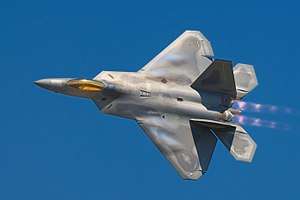 | |
| An F-22 Raptor flies over Andrews Air Force Base in 2008. | |
| Role | Stealth air superiority fighter |
| National origin | United States |
| Manufacturer | Lockheed Martin Aeronautics Boeing Defense, Space & Security |
| First flight | 7 September 1997 |
| Introduction | 15 December 2005 |
| Status | In service |
| Primary user | United States Air Force |
| Produced | 1996–2011 |
| Number built | 195 (8 test and 187 operational aircraft)[1] |
| Program cost | US$67.3 billion (as of 2010)[2] |
| Unit cost | |
| Developed from | Lockheed YF-22 |
| Developed into | Lockheed Martin X-44 MANTA Lockheed Martin FB-22 |
The aircraft was variously designated F-22 and F/A-22 before it formally entered service in December 2005 as the F-22A. Despite its protracted development and various operational issues, USAF officials consider the F-22 a critical component of the service's tactical air power. Its combination of stealth, aerodynamic performance, and avionics systems enable unprecedented air combat capabilities.[5][6]
Service officials had originally planned to buy a total of 750 ATFs. In 2009, the program was cut to 187 operational production aircraft due to high costs, a lack of clear air-to-air missions due to delays in Russian and Chinese fighter programs, a ban on exports, and development of the more versatile F-35.[N 1] The last F-22 was delivered in 2012.
Development
Origins
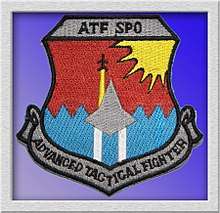
In 1981, the U.S. Air Force identified a requirement for an Advanced Tactical Fighter (ATF) to replace the F-15 Eagle and F-16 Fighting Falcon. Code named "Senior Sky", this air-superiority fighter program was influenced by emerging worldwide threats, including new developments in Soviet air defense systems and the proliferation of the Su-27 "Flanker"- and MiG-29 "Fulcrum"-class of fighter aircraft.[8] It would take advantage of the new technologies in fighter design on the horizon, including composite materials, lightweight alloys, advanced flight control systems, more powerful propulsion systems, and most importantly, stealth technology. In 1983, the ATF concept development team became the System Program Office (SPO) and managed the program at Wright-Patterson Air Force Base. The demonstration and validation (Dem/Val) request for proposals (RFP) was issued in September 1985, with requirements placing strong emphasis on stealth and supercruise. Of the seven bidding companies, Lockheed and Northrop were selected on 31 October 1986. Lockheed teamed with Boeing and General Dynamics while Northrop teamed with McDonnell Douglas, and the two contractor teams undertook a 50-month Dem/Val phase, culminating in the flight test of two technology demonstrator prototypes, the YF-22 and the YF-23, respectively. Concurrently, Pratt & Whitney and General Electric were awarded contracts to develop the YF119 and YF120 respectively for the ATF engine competition.[9][10]
Dem/Val was focused on risk reduction and technology development plans over specific aircraft designs.[N 2] Contractors made extensive use of analytical and empirical methods, including computational fluid dynamics, wind-tunnel testing, and radar cross-section calculations and pole testing; the Lockheed team would conduct nearly 18,000 hours of wind-tunnel testing. Avionics development was marked by extensive testing and prototyping and supported by ground and flying laboratories.[12] During Dem/Val, the SPO used the results of performance and cost trade studies conducted by contractor teams to adjust ATF requirements and delete ones that were significant weight and cost drivers while having marginal value. The short takeoff and landing (STOL) requirement was relaxed in order to delete thrust-reversers, saving substantial weight. As avionics was a major cost driver, side-looking radars were deleted, and the dedicated infra-red search and track (IRST) system was downgraded from multi-color to single color and then deleted as well. However, space and cooling provisions were retained to allow for future addition of these components. The ejection seat requirement was downgraded from a fresh design to the existing McDonnell Douglas ACES II. Despite efforts by the contractor teams to rein in weight, the takeoff gross weight estimate was increased from 50,000 lb (22,700 kg) to 60,000 lb (27,200 kg), resulting in engine thrust requirement increasing from 30,000 lbf (133 kN) to 35,000 lbf (156 kN) class.[13]
Each team produced two prototype air vehicles for Dem/Val, one for each of the two engine options. The YF-22 had its maiden flight on 29 September 1990 and in flight tests achieved up to Mach 1.58 in supercruise. After the Dem/Val flight test of the prototypes, on 23 April 1991, Secretary of the USAF Donald Rice announced the Lockheed team and Pratt & Whitney as the winners of the ATF and engine competitions.[14] The YF-23 design was considered stealthier and faster, while the YF-22, with its thrust vectoring nozzles, was more maneuverable as well as less expensive and risky.[15] The aviation press speculated that the Lockheed team's design was also more adaptable to the U.S. Navy's Navalized Advanced Tactical Fighter (NATF),[N 3] but by 1991, the Navy had abandoned NATF.[16]
Production and procurement
As the program moved to full-scale development, or Engineering & Manufacturing Development (EMD), the production version had notable differences from the YF-22, despite having a broadly similar shape. The wing's leading edge sweep angle was decreased from 48° to 42°, while the vertical stabilizers were shifted rearward and decreased in area by 20%.[17] To improve pilot visibility, the canopy was moved forward 7 inches (18 cm) and the engine intakes moved rearward 14 inches (36 cm). The shapes of the wing and stabilator trailing edges were refined to improve aerodynamics, strength, and stealth characteristics.[18][19] Increasing weight during development caused slight reductions in range and maneuver performance.[20]
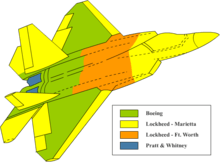
Prime contractor Lockheed Martin Aeronautics[N 4] manufactured the majority of the airframe and performed final assembly at Dobbins Air Reserve Base in Marietta, Georgia; program partner Boeing Defense, Space & Security provided additional airframe components as well as avionics integration and training systems.[21] The first F-22, an EMD aircraft with tail number 4001, was unveiled at Marietta, Georgia, on 9 April 1997 and first flew on 7 September 1997.[22][23] Production, with the first lot awarded in September 2000, supported over 1,000 subcontractors and suppliers from 46 states and up to 95,000 jobs, and spanned 15 years at a peak rate of roughly two airplanes per month.[24][25][26] In 2006, the F-22 development team won the Collier Trophy, American aviation's most prestigious award.[27] Due to the aircraft's advanced nature, contractors have been targeted by cyberattacks and technology theft.[28]
The USAF originally envisioned ordering 750 ATFs at a total program cost of $44.3 billion and procurement cost of $26.2 billion in fiscal year (FY) 1985 dollars, with production beginning in 1994. The 1990 Major Aircraft Review led by Secretary of Defense Dick Cheney reduced this to 648 aircraft beginning in 1996. By 1997, funding instability had further cut the total to 339, which was again reduced to 277 by 2003.[29] In 2004, the Department of Defense (DoD) further reduced this to 183 operational aircraft, despite the USAF's preference for 381.[30][31] A multi-year procurement plan was implemented in 2006 to save $15 billion, with total program cost projected to be $62 billion for 183 F-22s distributed to seven combat squadrons.[32] In 2008, Congress passed a defense spending bill that raised the total orders for production aircraft to 187.[33][34]
The first two F-22s built were EMD aircraft in the Block 1.0[N 5] configuration for initial flight testing and envelope expansion, while the third was a Block 2.0 aircraft built to represent the internal structure of production airframes and enabled it to test full flight loads. Six more EMD aircraft were built in the Block 10 configuration for development and upgrade testing, with the last two considered essentially production quality jets. Production for operational squadrons consisted of 74 Block 10/20 training aircraft and 112 Block 30/35/40 combat aircraft; one of the Block 30 aircraft is dedicated to flight sciences at Edwards Air Force Base.[35][36][37]
The numerous new technologies in the F-22 resulted in substantial cost overruns and delays.[38] Many capabilities were deferred to post-service upgrades, reducing the initial cost but increasing total program cost.[39] As production wound down in 2011, the total program cost is estimated to be about $67.3 billion, with $32.4 billion spent on Research, Development, Test and Evaluation (RDT&E) and $34.9 billion on procurement and military construction (MILCON) in then year dollars. The incremental cost for an additional F-22 was estimated at about $138 million in 2009.[40][2]
Ban on exports

The F-22 cannot be exported under US federal law to protect its stealth technology and classified features.[41][42] Customers for U.S. fighters are acquiring earlier designs such as the F-15 Eagle and F-16 Fighting Falcon or the newer F-35 Lightning II, which contains technology from the F-22 but was designed to be cheaper, more flexible, and available for export.[43] In September 2006, Congress upheld the ban on foreign F-22 sales.[44] Despite the ban, the 2010 defense authorization bill included provisions requiring the DoD to prepare a report on the costs and feasibility for an F-22 export variant, and another report on the effect of F-22 export sales on U.S. aerospace industry.[45][46]
Some Australian politicians and defense commentators proposed that Australia should attempt to purchase F-22s instead of the planned F-35s,[47][48] citing the F-22's known capabilities and F-35's delays and developmental uncertainties.[49] However, the Royal Australian Air Force (RAAF) determined that the F-22 was unable to perform the F-35's strike and close air support roles.[50] The Japanese government also showed interest in the F-22 for its Replacement-Fighter program. The Japan Air Self-Defense Force (JASDF) would reportedly require fewer fighters for its mission if it obtained the F-22, thus reducing engineering and staffing costs. However, in 2009 it was reported that acquiring the F-22 would require increases to the Japanese government's defense budget beyond the historical 1 percent of its GDP.[51][52] With the end of F-22 production, Japan chose the F-35 in December 2011.[53] Israel also expressed interest, but eventually chose the F-35 because of the F-22's price and unavailability.[54][55]
Production termination
Throughout the 2000s, the need for F-22s was debated, due to rising costs and the lack of relevant adversaries. In 2006, Comptroller General of the United States David Walker found that "the DoD has not demonstrated the need" for more investment in the F-22,[56] and further opposition to the program was expressed by Secretary of Defense Donald Rumsfeld, Deputy Secretary of Defense Gordon R. England, and Chairman of U.S. Senate Committee on Armed Services Senators John Warner and John McCain.[57][58] The F-22 program lost influential supporters in 2008 after the forced resignations of Secretary of the Air Force Michael Wynne and the Chief of Staff of the Air Force General T. Michael Moseley.[59]
.jpg)
In November 2008, Secretary of Defense Robert Gates stated that the F-22 was not relevant in post-Cold War conflicts such as irregular warfare operations in Iraq and Afghanistan,[60] and in April 2009, under the new Obama Administration, he called for ending production in FY2011, leaving the USAF with 187 production aircraft.[61] In July, General James Cartwright, Vice Chairman of the Joint Chiefs of Staff, stated to the Senate Committee on Armed Services his reasons for supporting termination of F-22 production. They included shifting resources to the multirole F-35 to allow proliferation of fifth-generation fighters for three service branches and preserving the F/A-18 production line to maintain the military's electronic warfare (EW) capabilities in the Boeing EA-18G Growler.[62] Issues with the F-22's reliability and availability also raised concerns.[43][63] After President Obama threatened to veto further production, the Senate voted in July 2009 in favor of ending production and the House subsequently agreed to abide by the 187 production aircraft cap.[64][65] Gates stated that the decision was taken in light of the F-35's capabilities,[66] and in 2010, he set the F-22 requirement to 187 aircraft by lowering the number of major regional conflict preparations from two to one.[67]
In 2010, USAF initiated a study to determine the costs of retaining F-22 tooling for a future Service Life Extension Program (SLEP).[68] A RAND Corporation paper from this study estimated that restarting production and building an additional 75 F-22s would cost $17 billion, resulting in $227 million per aircraft, $54 million higher than the flyaway cost.[69] Lockheed Martin stated that restarting the production line itself would cost about $200 million.[70] Production tooling and associated documentation were subsequently stored at the Sierra Army Depot to support the fleet life cycle.[71] There were reports that attempts to retrieve this tooling found empty containers,[72] but a subsequent audit found that the tooling was stored as expected.[73]
Russian and Chinese fighter developments have fueled concern, and in 2009, General John Corley, head of Air Combat Command, stated that a fleet of 187 F-22s would be inadequate, but Secretary Gates dismissed General Corley's concern.[59] In 2011, Gates explained that Chinese fifth-generation fighter developments had been accounted for when the number of F-22s was set, and that the U.S. would have a considerable advantage in stealth aircraft in 2025, even with F-35 delays.[74] In December 2011, the 195th and final F-22 was completed out of 8 test EMD and 187 operational aircraft produced; the aircraft was delivered to the USAF on 2 May 2012.[75][76]
In April 2016, the House Armed Services Committee (HASC) Tactical Air and Land Forces Subcommittee proposed legislation that would direct the Air Force to conduct a cost study and assessment associated with resuming production of the F-22. Since the production halt directed in 2009 by then Defense Secretary Gates, lawmakers and the Pentagon noted that air warfare systems of Russia and China were catching up to those of the U.S.[77] Lockheed Martin has proposed upgrading some Block 20 training aircraft into combat-coded Block 30/35 versions as a way to increase numbers available for deployment.[78] On 9 June 2017, the Air Force submitted their report to Congress stating they had no plans to restart the F-22 production line due to economic and operational issues; it estimated it would cost approximately $50 billion to procure 194 additional F-22s at a cost of $206–$216 million per aircraft, including approximately $9.9 billion for non-recurring start-up costs and $40.4 billion for aircraft procurement costs.[79]
Upgrades
The first aircraft with combat-capable Block 3.0 software flew in 2001.[80] Increment 2, the first upgrade program, was implemented in 2005 for Block 20 aircraft onward and enabled the employment of Joint Direct Attack Munitions (JDAM). Certification of the improved AN/APG-77(V)1 radar was completed in March 2007, and airframes from production Lot 5 onward were fitted with this radar, which incorporates air-to-ground modes.[81] Increment 3.1 for Block 30 aircraft onward provided improved ground-attack capability through synthetic aperture radar mapping and radio emitter direction finding, electronic attack and Small Diameter Bomb (SDB) integration; testing began in 2009 and the first upgraded aircraft was delivered in 2011.[82][83] To address oxygen deprivation issues, F-22s were fitted with an automatic backup oxygen system (ABOS) and modified life support system starting in 2012.[84]
Increment 3.2 for Block 35/40 aircraft is a two-part upgrade process; 3.2A focuses on electronic warfare, communications and identification, while 3.2B includes geolocation improvements and a new stores management system to fully integrate the AIM-9X and AIM-120D.[85][86] To enable two-way communication with other platforms, the F-22 can use the Battlefield Airborne Communications Node (BACN) as a gateway. The planned Multifunction Advanced Data Link (MADL) integration was cut due to development delays and lack of proliferation among USAF platforms. The F-22 fleet began receiving Increment 3.2B and upgraded software for cryptography capabilities and avionics stability in May 2019. A Multifunctional Information Distribution System-Joint (MIDS-J) radio that replaces the current Link-16 receive-only box is expected to be operational by 2020. Subsequent upgrades are also focusing on having an open architecture and agile software development to enable faster future enhancements.[87][88]
In 2024, funding is projected to begin for the F-22 mid-life upgrade (MLU), which is expected to include new sensors and antennas, hardware refresh, cockpit improvements, and a helmet mounted display and cuing system. Other enhancements being developed include IRST functionality for the AN/AAR-56 Missile Launch Detector (MLD) and more durable stealth coating based on the F-35's.[87][89][90]
The F-22 was designed for a service life of 8,000 flight hours, with a $350 million "structures retrofit program".[91] Investigations are being made for upgrades to extend their useful lives further.[92] In the long term, the F-22 is expected to eventually be succeeded by a sixth-generation jet fighter.[93]
Design
Overview
The F-22 Raptor is a fifth-generation fighter that is considered fourth generation in stealth aircraft technology by the USAF.[94] It is the first operational aircraft to combine supercruise, supermaneuverability, stealth, and sensor fusion in a single weapons platform.[95] The F-22 has four empennage surfaces, retractable tricycle landing gear, and clipped delta wings with reverse trailing edge sweep and leading edge extensions running to the upper outboard corner of the inlets. Flight control surfaces include leading-edge flaps, flaperons, ailerons, rudders on the canted vertical stabilizers, and all-moving horizontal tails (stabilators); for speed brake function, the ailerons deflect up, flaperons down, and rudders outwards to increase drag.[96]
The aircraft's dual Pratt & Whitney F119-PW-100 augmented turbofan engines are closely spaced and incorporate pitch-axis thrust vectoring nozzles with a range of ±20 degrees; each engine has maximum thrust in the 35,000 lbf (156 kN) class. The F-22's thrust-to-weight ratio at typical combat weight is nearly at unity in maximum military power and 1.25 in full afterburner. Maximum speed without external stores is approximately Mach 1.8 at military power and greater than Mach 2 with afterburners.[97][N 6]
The F-22's high cruise speed and operating altitude over prior fighters improve the effectiveness of its sensors and weapon systems, and increase survivability against ground defenses such as surface-to-air missiles.[99][100] The ability to supercruise, or sustain supersonic flight without using afterburners, allows it to intercept targets which subsonic aircraft would lack the speed to pursue and afterburner-dependent aircraft would lack the fuel to reach. The F-22's thrust and aerodynamics enable regular combat speeds of Mach 1.5 at 50,000 feet (15,000 m).[101] The use of internal weapons bays permits the aircraft to maintain comparatively higher performance over most other combat-configured fighters due to a lack of parasitic drag from external stores. The airplane's structure contains a significant amount of high-strength materials to withstand stress and heat of sustained supersonic flight. Respectively, titanium alloys and composites comprise 39% and 24% of the structural weight.[102]
The F-22's aerodynamics, relaxed stability, and powerful thrust-vectoring engines give it excellent maneuverability and energy potential across its flight envelope. The airplane has excellent high alpha (angle of attack) characteristics, capable of flying at trimmed alpha of over 60° while maintaining roll control and performing maneuvers such as the Herbst maneuver (J-turn) and Pugachev's Cobra.[103] The flight control system and full-authority digital engine control (FADEC) make the aircraft highly departure resistant and controllable, thus giving the pilot carefree handling.[104][105]
Avionics
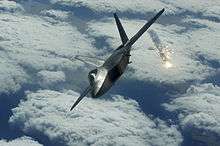
The aircraft has an integrated avionics system where through sensor fusion, data from the radar, other sensors, and external systems are filtered and combined into a common view, thus enhancing the pilot's situational awareness and reducing workload. Key systems include Sanders/General Electric AN/ALR-94 electronic warfare system, Lockheed Martin AN/AAR-56 infrared and ultraviolet Missile Launch Detector (MLD), Westinghouse/Texas Instruments AN/APG-77 active electronically scanned array (AESA) radar, and TRW Communication/Navigation/Identification (CNI) suite. The MLD uses six sensors to provide full spherical infrared coverage.[106] Among the most technically complex equipment on the airplane is the ALR-94 system, a passive radar detector with more than 30 antennas blended into the wings and fuselage for all-round radar warning receiver (RWR) coverage. Its range (250+ nmi) exceeds the radar's and can cue radar emissions to be confined to a narrow beam (down to 2° by 2° in azimuth and elevation) to increase stealth. Depending on the detected threat, the defensive systems can prompt the pilot to release countermeasures such as flares or chaff. The ALR-94 can be used as a passive detection system capable of searching targets and providing enough information for a radar lock on. Tactical communication between F-22s is performed using the directional Inter/Intra-Flight Data Link (IFDL).[107][108]

The APG-77 radar has a low-observable, active-aperture, electronically scanned array that can track multiple targets under any weather conditions. Radar emissions can also be focused to overload enemy sensors as an electronic-attack capability. The radar changes frequencies more than 1,000 times per second to lower interception probability and has an estimated range of 125–150 mi (201–241 km) against a 11 sq ft (1 m2) target and 250 mi (400 km) or more in narrow beams. F-22s from Lot 5 and on are equipped with the APG-77(V)1, which provides air-to-ground functionality through synthetic aperture radar mapping and various strike modes.[81][109] Radar and CNI information are processed by two Hughes Common Integrated Processor (CIP)s, each capable of processing up to 10.5 billion instructions per second.[110] The aircraft has also been upgraded to incorporate an automatic ground collision avoidance system (GCAS).[111]
The F-22's ability to operate close to the battlefield gives the aircraft threat detection and identification capability comparative with the RC-135 Rivet Joint, and the ability to function as a "mini-AWACS", though its radar is less powerful than those of dedicated platforms. This allows the F-22 to rapidly designate targets for allies and coordinate friendly aircraft.[109] Data can be transferred to other aircraft via Link 16 using the MIDS-J radio.[87] The IEEE 1394B bus developed for the F-22 was derived from the commercial IEEE 1394 "FireWire" bus system.[112] In 2007, the F-22's radar was tested as a wireless data transceiver, transmitting data at 548 megabits per second and receiving at gigabit speed, far faster than the Link 16 system.[113]
The F-22's software has some 1.7 million lines of code, the majority involving processing radar data.[114] Former Secretary of the USAF Michael Wynne blamed the use of the DoD's Ada for cost overruns and delays on many military projects, including the F-22. The integrated nature of the avionics have also made upgrades challenging; consequently, open-system architecture for the aircraft is currently planned in order to facilitate future upgrades.[87][115]
Cockpit
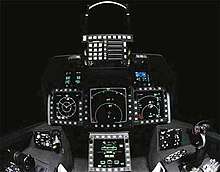
The F-22 has a glass cockpit with all-digital flight instruments. The monochrome head-up display offers a wide field of view and serves as a primary flight instrument; information is also displayed upon six color liquid-crystal display (LCD) panels.[116] The primary flight controls are a force-sensitive side-stick controller and a pair of throttles. The USAF initially wanted to implement direct voice input (DVI) controls, but this was judged to be too technically risky and was abandoned.[117] The canopy's dimensions are approximately 140 inches long, 45 inches wide, and 27 inches tall (355 cm × 115 cm × 69 cm) and weighs 360 pounds.[118] The canopy was redesigned after the original design lasted an average of 331 hours instead of the required 800 hours.[63]
The F-22 has integrated radio functionality, the signal processing systems are virtualized rather than as a separate hardware module.[119] The integrated control panel (ICP) is a keypad system for entering communications, navigation, and autopilot data. Two 3 in × 4 in (7.6 cm × 10.2 cm) up-front displays located around the ICP are used to display integrated caution advisory/warning (ICAW) data, CNI data and also serve as the stand-by flight instrumentation group and fuel quantity indicator.[120] The stand-by flight group displays an artificial horizon, for basic instrument meteorological conditions. The 8 in × 8 in (20 cm × 20 cm) primary multi-function display (PMFD) is located under the ICP, and is used for navigation and situation assessment. Three 6.25 in × 6.25 in (15.9 cm × 15.9 cm) secondary multi-function displays are located around the PMFD for tactical information and stores management.[121]
The ejection seat is a version of the ACES II commonly used in USAF aircraft, with a center-mounted ejection control.[122] The F-22 has a complex life support system, which includes the on-board oxygen generation system (OBOGS), protective pilot garments, and a breathing regulator/anti-g (BRAG) valve controlling flow and pressure to the pilot's mask and garments. The pilot garments were developed under the Advanced Technology Anti-G Suit (ATAGS) project and protect against chemical/biological hazards and cold-water immersion, counter g-forces and low pressure at high altitudes, and provide thermal relief.[123] Following a series of hypoxia-related issues, the life support system was revised to include an automatic backup oxygen system and a new flight vest valve.[84]
Armament
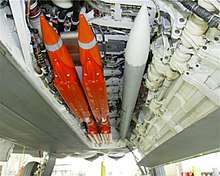
The F-22 has three internal weapons bays: a large main bay on the bottom of the fuselage, and two smaller bays on the sides of the fuselage, aft of the engine intakes.[124] The main bay is split along the centerline and can accommodate six LAU-142/A launchers for beyond-visual-range missiles and each side bay has an LAU-141/A launcher for short-range missiles.[125] Four of the launchers in the main bay can be replaced with two bomb racks that can each carry one 1,000 lb (450 kg) or four 250 lb (110 kg) bombs.[95] Carrying armaments internally maintains the aircraft's stealth and minimizes additional drag. Missile launches require the bay doors to be open for less than a second, during which pneumatic or hydraulic arms push missiles clear of the aircraft; this is to reduce vulnerability to detection and to deploy missiles during high speed flight.[126]
The F-22 can carry air-to-surface weapons such as bombs with JDAM guidance and the Small Diameter Bomb, but cannot self-designate for laser-guided weapons.[127] Internal air-to-surface ordnance is limited to 2,000 lb (910 kg).[128] An internally mounted M61A2 Vulcan 20 mm rotary cannon is embedded in the airplane's right wing root with the muzzle covered by a retractable door to maintain stealth.[129] The radar projection of the cannon fire's path is displayed on the pilot's head-up display.[130]
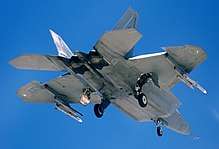
The F-22's high cruise speed and altitude increase the effective ranges of its munitions, with the aircraft having 50% greater employment range for the AIM-120 AMRAAM and twice the effective range for JDAMs than prior platforms.[105][131] In testing, an F-22 dropped a GBU-32 JDAM from 50,000 feet (15,000 m) while cruising at Mach 1.5, striking a moving target 24 miles (39 km) away.[132]
While the F-22 typically carries weapons internally, the wings include four hardpoints, each rated to handle 5,000 lb (2,300 kg). Each hardpoint can accommodate a pylon that can carry a detachable 600-gallon (2,270 L) external fuel tank or a launcher holding two air-to-air missiles; the two inboard hardpoints are "plumbed" for external fuel tanks. The use of external stores degrades the aircraft's stealth and kinematic performance; after releasing stores the external attachments can be jettisoned to restore those characteristics.[133] A stealthy ordnance pod and pylon was being developed to carry additional weapons in the mid-2000s.[134]
Stealth
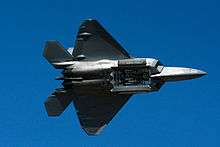
The F-22 was designed to be highly difficult to detect and track by radar. Measures to reduce radar cross-section (RCS) include airframe shaping such as alignment of edges, fixed-geometry serpentine inlets and curved vanes that prevent line-of-sight of the engine faces and turbines from any exterior view, use of radar-absorbent material (RAM), and attention to detail such as hinges and pilot helmets that could provide a radar return. The F-22 was also designed to have decreased radio emissions, infrared signature and acoustic signature as well as reduced visibility to the naked eye.[135] The aircraft's flat thrust-vectoring nozzles reduce infrared emissions of the exhaust plume to mitigate the threat of infrared homing ("heat seeking") surface-to-air or air-to-air missiles.[136] Additional measures to reduce the infrared signature include special topcoat and active cooling of leading edges to manage the heat buildup from supersonic flight.[137]
Compared to previous stealth designs like the F-117, the F-22 is less reliant on RAM, which are maintenance-intensive and susceptible to adverse weather conditions. Unlike the B-2, which requires climate-controlled hangars, the F-22 can undergo repairs on the flight line or in a normal hangar. The F-22 has a Signature Assessment System which delivers warnings when the radar signature is degraded and necessitates repair.[109] While the F-22's exact RCS is classified, in 2009 Lockheed Martin released information indicating that from certain angles the airplane has an RCS of 0.0001 m² or −40 dBsm – equivalent to the radar reflection of a "steel marble"; the aircraft can mount a Luneburg lens reflector to mask its RCS.[138][139] Effectively maintaining the stealth features can decrease the F-22's mission capable rate to 62–70%.[N 7]
_arrives_at_the_2016_RIAT_Fairford_7Jul2016_arp.jpg)
The effectiveness of the stealth characteristics is difficult to gauge. The RCS value is a restrictive measurement of the aircraft's frontal or side area from the perspective of a static radar. When an aircraft maneuvers it exposes a completely different set of angles and surface area, potentially increasing radar observability. Furthermore, the F-22's stealth contouring and radar absorbent materials are chiefly effective against high-frequency radars, usually found on other aircraft. The effects of Rayleigh scattering and resonance mean that low-frequency radars such as weather radars and early-warning radars are more likely to detect the F-22 due to its physical size. However, such radars are also conspicuous, susceptible to clutter, and have low precision.[141] Additionally, while faint or fleeting radar contacts make defenders aware that a stealth aircraft is present, reliably vectoring interception to attack the aircraft is much more challenging.[142][143] According to the USAF an F-22 surprised an Iranian F-4 Phantom II that was attempting to intercept an American UAV, despite Iran's assertion of having military VHF radar coverage over the Persian Gulf.[144]
Operational history
Designation and testing
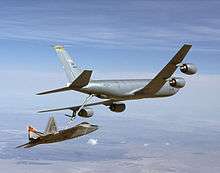
The YF-22 was originally given the unofficial name "Lightning II", after the World War II Lockheed P-38 Lightning fighter, which persisted until the mid-1990s, when the USAF officially named the aircraft "Raptor"; "Lightning II" was later given to the F-35. The aircraft was also briefly dubbed "SuperStar" and "Rapier".[145] In September 2002, USAF changed the Raptor's designation to F/A-22, mimicking the Navy's McDonnell Douglas F/A-18 Hornet and intended to highlight a planned ground-attack capability amid debate over the aircraft's role and relevance. The F-22 designation was reinstated in December 2005, when the aircraft entered service.[95][146]
Flight testing of the F-22 began in 1997 with Raptor 4001, the first EMD jet, and eight more EMD F-22s would participate in the flight test program as the Combined Test Force (CTF) at Edwards AFB. The first two aircraft tested flying qualities, air vehicle performance, propulsion, and stores separation. The third aircraft, the first to have production-level internal structure, tested flight loads, flutter, and JDAM separation, while two non-flying F-22s were built for static loads testing and fatigue testing. Subsequent EMD aircraft tested avionics, CNI, and observables.[35] Raptor 4001 was retired from flight testing in 2000 and subsequently sent to Wright-Patterson Air Force Base for survivability testing, including live fire testing and battle damage repair training.[147] Other EMD F-22s have been used for testing upgrades and as maintenance trainers.[148] The first production F-22 was delivered to Nellis AFB, Nevada, in January 2003 for Initial Operational Test & Evaluation (IOT&E).[149]
In May 2006, a released report documented a problem with the F-22's forward titanium boom, caused by defective heat-treating. This made the boom on roughly the first 80 F-22s less ductile than specified and potentially shortened the part's life. Modifications and inspections were implemented to the booms to restore life expectancy.[92][150]
In August 2008, an unmodified F-22 of the 411th Flight Test Squadron performed the first ever air-to-air refueling of an aircraft using synthetic jet fuel as part of a wider USAF effort to qualify aircraft to use the fuel, a 50/50 mix of JP-8 and a Fischer–Tropsch process-produced, natural gas-based fuel.[151] In 2011, an F-22 flew supersonic on a 50% mixture of biofuel derived from camelina.[152]
Introduction into service
.jpg)
In December 2005, the USAF announced that the F-22 had achieved Initial Operational Capability (IOC).[153] During Exercise Northern Edge in Alaska in June 2006, in simulated combat exercises 12 F-22s of the 94th FS downed 108 adversaries with no losses.[32] In the exercises, the Raptor-led Blue Force amassed 241 kills against two losses in air-to-air combat, with neither "loss" being an F-22. During Exercise Red Flag 07–1 in February 2007, 14 F-22s of the 94th FS supported Blue Force strikes and undertook close air support sorties. Against superior numbers of Red Force Aggressor F-15s and F-16s, 6–8 F-22s maintained air dominance throughout and provided airborne electronic surveillance. No sorties were missed because of maintenance or other failures; a single F-22 was judged "lost" against the defeated opposing force.[154]
The F-22 achieved Full Operational Capability (FOC) in December 2007, when General John Corley of Air Combat Command (ACC) officially declared the F-22s of the integrated active duty 1st Fighter Wing and Virginia Air National Guard 192d Fighter Wing fully operational.[155] This was followed by an Operational Readiness Inspection (ORI) of the integrated wing in April 2008, in which it was rated "excellent" in all categories, with a simulated kill-ratio of 221–0.[156]
Maintenance and training
Each airplane requires a three-week packaged maintenance plan (PMP) every 300 flight hours.[157] The stealth coatings of the F-22 were designed to be more robust and weather-resistant than those used in earlier stealth aircraft.[109] However, early coatings still experienced issues with rain and moisture when F-22s were initially posted to Guam in 2009.[158] The stealth system account for almost one third of maintenance, with coatings being particularly demanding. More durable stealth coatings derived from the F-35's are being considered for future upgrades in order to reduce maintenance efforts.[159][87] F-22 depot maintenance is performed at Ogden Air Logistics Complex at Hill AFB, Utah.[160]
F-22s were available for missions 63% of the time on average in 2015, up from 40% when the aircraft was introduced in 2005. Maintenance hours per flight hour was also improved from 30 early on to 10.5 by 2009, lower than the requirement of 12; man-hours per flight hour was 43 in 2014. When introduced, the F-22 had a Mean Time Between Maintenance (MTBM) of 1.7 hours, short of the required 3.0; this rose to 3.2 hours in 2012.[63][91] By fiscal year 2015, the cost per flight hour was $59,116.[161]
To reduce operating costs and lengthen the F-22's service life, some pilot training sorties are performed using flight simulators, while the T-38 Talon is used for adversary training. Attrition reserve aircraft numbers are limited due to the small fleet size.[157]
Deployments
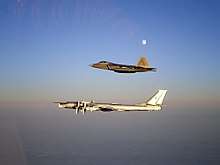
F-22 fighter units have been frequently deployed to Kadena Air Base in Okinawa, Japan.[162] In February 2007, on the aircraft's first overseas deployment to Kadena Air Base, six F-22s of 27th Fighter Squadron flying from Hickam AFB, Hawaii, experienced multiple software-related system failures while crossing the International Date Line (180th meridian of longitude). The aircraft returned to Hawaii by following tanker aircraft. Within 48 hours, the error was resolved and the journey resumed.[163][164] F-22s have also been involved in training exercises in South Korea and Malaysia.[165][166]
In November 2007, F-22s of 90th Fighter Squadron at Elmendorf AFB, Alaska, performed their first NORAD interception of two Russian Tu-95MS bombers.[167] Since then, F-22s have also escorted probing Tu-160 bombers.[168]
Defense Secretary Gates initially refused to deploy F-22s to the Middle East in 2007;[169] the type made its first deployment in the region at Al Dhafra Air Base in the UAE in 2009. In April 2012, F-22s have been rotating into Al Dhafra, less than 200 miles from Iran;[170][171] the Iranian defense minister referred to the deployment as a security threat.[172] In March 2013, the USAF announced that an F-22 had intercepted an Iranian F-4 Phantom II that approached within 16 miles of an MQ-1 Predator flying off the Iranian coastline.[144]
On 22 September 2014, F-22s performed the type's first combat sorties by conducting some of the opening strikes of Operation Inherent Resolve, the American-led intervention in Syria; aircraft dropped 1,000-pound GPS-guided bombs on Islamic State targets near Tishrin Dam.[173][174] Between September 2014 and July 2015, F-22s flew 204 sorties over Syria, dropping 270 bombs at some 60 locations.[175] Throughout their deployment, F-22s conducted close air support (CAS) and also deterred Syrian, Iranian, and Russian aircraft from attacking U.S.-backed Kurdish forces and disrupting U.S. operations in the region.[176][177][178] F-22s also participated in the U.S. strikes on pro-government forces in eastern Syria on 7 February 2018.[179][180][181] These strikes notwithstanding, the F-22's main role in the operation was gathering intelligence, surveillance and reconnaissance.[182]
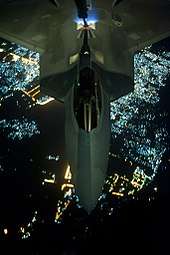
In late 2014, the USAF was testing a rapid deployment concept involving four F-22s and one C-17 for support, first proposed in 2008 by two F-22 pilots. The goal was for the type to be able to set up and engage in combat within 24 hours.[183][184] Four F-22s were deployed to Spangdahlem Air Base in Germany in August and Lask Air Base in Poland and Amari Air Base in Estonia in September 2015 to train with NATO allies.[185]
In November 2017, F-22s operating alongside B-52s bombed opium production and storage facilities in Taliban-controlled regions of Afghanistan.[186] In 2019, the F-22 cost US$35,000 per flight hour to operate.[187]
Operational problems
During the initial years of service, F-22 pilots experienced symptoms that include loss of consciousness, memory loss, emotional lability and neurological changes as well as lingering respiratory problems and a chronic cough.[188] A number of possible causes were investigated, including noxious chemicals in the respiratory tubing, pressure suit malfunction, and oxygen supply disruption. The fleet was grounded for four months in 2011 before resuming flight, but reports of oxygen issues persisted.[189] The problems resulted in inflight brain monitoring being considered by the USAF.[190] In August 2012, the DoD found that the BRAG valve, used to inflate the pilot's vest during high-g maneuvers, was defective, inflating the vest at unintended intervals and restricting the pilot's breathing.[191] The OBOGS also unexpectedly reduced oxygen levels during high-g maneuvers.[192]
In 2005, the Raptor Aeromedical Working Group, a USAF expert panel, recommended several changes to deal with the oxygen supply issues, though they were initially not funded on cost grounds; the recommended changes received further consideration in 2012.[193][194] The F-22 CTF and 412th Aerospace Medicine Squadron eventually determined that breathing restrictions on the pilot were the root cause. The coughing symptoms have been attributed to acceleration atelectasis[N 8] from high g exposure and the OBOGS delivering excessive oxygen concentrations at low altitudes. The presence of toxins and particles in some ground crew was deemed to be unrelated.[195] Modifications to the life-support equipment and oxygen system allowed the distance and altitude flight restrictions to be lifted on 4 April 2013.[84][196][197]
Variants
- YF-22A – pre-production technology demonstrator for Advanced Tactical Fighter (ATF) demonstration/validation phase; two were built.
- F-22A – single-seat production version, was designated F/A-22A in early 2000s.
- F-22B – planned two-seat variant, cancelled in 1996 to save development costs with test aircraft orders converted to F-22A.[198]
- Naval F-22 variant – a planned carrier-borne variant of the F-22 with variable-sweep wings for the U.S. Navy's Navy Advanced Tactical Fighter (NATF) program to replace the F-14 Tomcat. Program was cancelled in 1991.[198]
Derivatives
The FB-22 was a proposed medium-range supersonic stealth bomber for the USAF.[199] The design was projected to carry up to 30 Small Diameter Bombs to about twice the range of the F-22A.[200] However, the FB-22 proposal appears to have been cancelled with the 2006 Quadrennial Defense Review and subsequent developments, in lieu of a larger subsonic bomber with a much greater range.[201][202]
The X-44 MANTA, or multi-axis, no-tail aircraft, was a planned experimental aircraft based on the F-22 with enhanced thrust vectoring controls and no aerodynamic surface backup.[203] The aircraft was to be solely controlled by thrust vectoring, without featuring any rudders, ailerons, or elevators. Funding for this program was halted in 2000.[204]
In August 2018, Lockheed Martin proposed an F-22 derivative to the USAF and JASDF that would combine an improved F-22 airframe with the avionics and improved stealth coatings of the F-35.[205] The proposal was not considered by the USAF, while JASDF doubted its merits due to cost and existing export restrictions.[206][207]
Operators
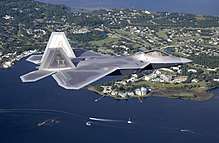
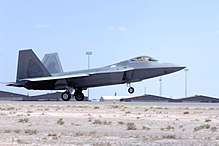
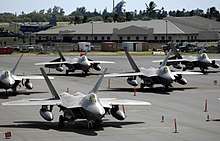
The United States Air Force is the only operator of the F-22. In August 2019, it had 183 production aircraft in inventory.[208][209]
Frontline Squadrons
- 1st Fighter Wing, at Langley Air Force Base, Virginia
- 27th Fighter Squadron[210]
- 94th Fighter Squadron
- 43rd Fighter Squadron (Training Unit), at Eglin Air Force Base, Florida (Originally based at Tyndall Air Force Base, relocated after Hurricane Michael to Eglin, scheduled to move to Langley Air Force Base.)[211]
- 3rd Wing, at Joint Base Elmendorf–Richardson, Alaska
- 154th Wing, at Hickam Air Force Base, Hawaii
Test and Evaluation Squadrons
- 57th Wing, at Nellis Air Force Base, Nevada
- 422nd Test and Evaluation Squadron[153]
- 433rd Weapons Squadron[213]
- 412th Test Wing, at Edwards Air Force Base, California
Accidents
The first F-22 crash occurred during takeoff at Nellis AFB on 20 December 2004, in which the pilot ejected safely before impact.[214] The investigation revealed that a brief interruption in power during an engine shutdown prior to flight caused a flight-control system malfunction;[35][215] consequently the aircraft design was corrected to avoid the problem. Following a brief grounding, F-22 operations resumed after a review.[216]
On 25 March 2009, an EMD F-22 crashed 35 miles (56 km) northeast of Edwards AFB during a test flight, resulting in the death of Lockheed Martin test pilot David P. Cooley. An Air Force Materiel Command investigation found that Cooley momentarily lost consciousness during a high-G maneuver, then ejected when he found himself too low to recover. Cooley was killed during ejection by blunt-force trauma from windblast due to the aircraft's speed. The investigation found no design issues.[217][218]
On 16 November 2010, an F-22 from Elmendorf AFB crashed, killing the pilot, Captain Jeffrey Haney. F-22s were restricted to flying below 25,000 feet, then grounded during the investigation.[219] The crash was attributed to a bleed air system malfunction after an engine overheat condition was detected, shutting down the Environmental Control System (ECS) and OBOGS. The accident review board ruled Haney was to blame, as he did not react properly to engage the emergency oxygen system.[220] Haney's widow sued Lockheed Martin, claiming equipment defects, and later reached a settlement.[221][222][195] After the ruling, the emergency oxygen system engagement handle was redesigned; the system was eventually replaced by an automatic backup oxygen system (ABOS).[223] On 11 February 2013, the DoD's Inspector General released a report stating that the USAF had erred in blaming Haney, and that facts did not sufficiently support conclusions; the USAF stated that it stood by the ruling.[224]
During a training mission, an F-22 crashed to the east of Tyndall AFB, on 15 November 2012. The pilot ejected safely and no injuries were reported on the ground.[225] The investigation determined that a "chafed" electrical wire ignited the fluid in a hydraulic line, causing a fire that damaged the flight controls.[226]
On 15 May 2020, an F-22 from Eglin Air Force Base crashed during a routine training mission. The pilot ejected safely, and the aircraft crashed in a remote part of Eglin Air Force Base reservation.[227]
Aircraft on display
EMD F-22A 91-4003 is on display at the National Museum of the United States Air Force.[228]
Specifications (F-22A)
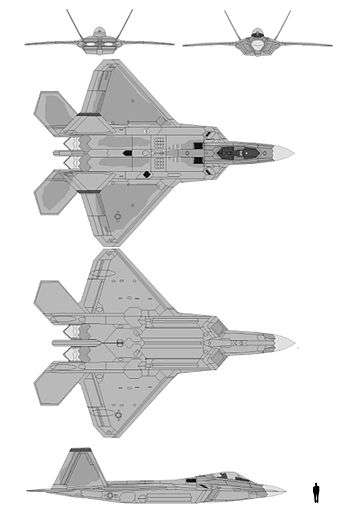
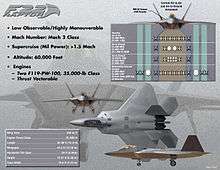

Data from USAF,[95] manufacturers' data,[229][230][231] Aviation Week,[109][232] AirForces Monthly,[97] and Journal of Electronic Defense,[108]
General characteristics
- Crew: 1
- Length: 62 ft 1 in (18.92 m)
- Wingspan: 44 ft 6 in (13.56 m)
- Height: 16 ft 8 in (5.08 m)
- Wing area: 840 sq ft (78.04 m2)
- Aspect ratio: 2.36
- Airfoil: NACA 6 series airfoil
- Empty weight: 43,340 lb (19,700 kg)
- Gross weight: 64,840 lb (29,410 kg)
- Max takeoff weight: 83,500 lb (38,000 kg)
- Fuel capacity: 18,000 lb (8,200 kg) internally, or 26,000 lb (12,000 kg) with two 2× 600 US gal tanks
- Powerplant: 2 × Pratt & Whitney F119-PW-100 augmented turbofans, 26,000 lbf (116 kN) thrust each dry, 35,000 lbf (156 kN) with afterburner[N 9]
Performance
- Maximum speed: Mach 2.25 (1,500 mph, 2,414 km/h) at altitude
- Mach 1.21, 800 knots (921 mph; 1,482 km/h) at sea level
- Mach 1.82 (1,220 mph, 1,963 km/h) supercruise at altitude
- Range: 1,600 nmi (1,800 mi, 3,000 km) or more with 2 external fuel tanks
- Combat range: 460 nmi (530 mi, 850 km) clean with 100 nmi (115 mi, 185 km) in supercruise
- 590 nmi (679 mi, 1,093 km) clean subsonic[N 10]
- Ferry range: 1,740 nmi (2,000 mi, 3,220 km)
- Service ceiling: 65,000 ft (20,000 m)
- g limits: +9.0/−3.0
- Wing loading: 77.2 lb/sq ft (377 kg/m2)
- Thrust/weight: 1.08 (1.25 with loaded weight and 50% internal fuel)
Armament
- Guns: 1× 20 mm (0.787 in) M61A2 Vulcan rotary cannon, 480 rounds
- Air-to-air mission loadout:
- Air-to-ground mission loadout:
- 2× 1,000 lb (450 kg) JDAM or 8× 250 lb (110 kg) GBU-39 Small Diameter Bombs
- 2× AIM-120 AMRAAM
- 2× AIM-9 Sidewinder
- Hardpoints: 4× under-wing pylon stations can be fitted to carry 600 U.S. gallon (2,270 L) drop tanks or weapons, each with a capacity of 5,000 lb (2,270 kg).[234]
Avionics
- AN/APG-77 or AN/APG-77(V)1 radar: 125–150 miles (201–241 km) against 1 m2 (11 sq ft) targets (estimated range), 250 miles (400 km) in narrow beams
- AN/AAR-56 Missile Launch Detector (MLD)
- AN/ALR-94 radar warning receiver (RWR): 250 nautical miles (460 km) or more detection range
- Integrated CNI Avionics
- MJU-39/40 flares for protection against IR missiles[235]
Notable appearances in media
See also
Related development
- Lockheed YF-22 – Prototype fighter aircraft for the US Air Force Advanced Tactical Fighter program
- Lockheed Martin FB-22 – Proposed bomber aircraft for the US Air Force derived from the F-22 Raptor
- Lockheed Martin X-44 MANTA – Conceptual aircraft design by Lockheed Martin
Aircraft of comparable role, configuration and era
- Chengdu J-20 – Chinese fifth-generation fighter aircraft
- Lockheed Martin F-35 Lightning II – Family of fifth-generation stealth combat aircraft
- Sukhoi Su-57 – Russian fifth-generation fighter aircraft
Related lists
References
Notes
- Referring to statements made by the Secretary of Defense Robert Gates: "The secretary once again highlighted his ambitious next-year request for the more-versatile F-35s."[7]
- In fact, the Lockheed team completely changed their airframe configuration in summer of 1987 after the Dem/Val down-select. Notable changes include the wing planform from swept trapezoidal to diamond-like and a reduction in forebody planform area.[11]
- The naval F-22 design was to be carrier-borne and had variable-sweep wings and additional sensors.
- Lockheed acquired General Dynamics fighter division at Fort Worth in 1993 and merged with Martin Marietta in 1995 to form Lockheed Martin.
- Block number designates production variation groups.
- This capability was demonstrated in 2005 when General John P. Jumper exceeded Mach 1.7 in the F-22 without afterburners.[98]
- "... noting that Raptors are ready for a mission around 62 percent of the time, if its low-observable requirements are met (DAILY, 20 November). Reliability goes up above 70 percent for missions with lower stealth demands."[140]
- Atelectasis is the collapse or closure of a lung resulting in reduced or absent gas exchange.
- Actual thrust is up to 37,000 lbf (165 kN).[233]
- 750 nmi (with 100 nmi in supercruise), 860 nmi subsonic with 2× 600 US gal tanks. Figures include −6% routing factor, combat and 2× GBU-32 + 2× AIM-9 + 2× AIM-120.
Citations
- Parsons, Gary. "Final F-22 Delivered" Archived 13 March 2016 at the Wayback Machine Combat Aircraft Monthly, 3 May 2012. Retrieved: 10 April 2014.
- "Selected Acquisition Report (SAR) - F-22, RCS: DD-A&T(Q&A)823-265." Department of Defense, 31 December 2010. Retrieved: 13 March 2019.
- "FY 2011 Budget Estimates" (PDF). U.S. Air Force. February 2010. pp. 1–15. Archived from the original (PDF) on 4 March 2012.
- Reed, John. "Official: Fighters should be used for spying." Air Force Times, 20 December 2009. Retrieved: 9 May 2010.
- Pace 1999, p. 95.
- Aronstein and Hirschberg 1998, p. 254.
- Baron, Kevin (16 September 2009). "Gates outlines Air Force priorities and expectations". Stars and Stripes. Archived from the original on 31 October 2013. Retrieved 30 October 2013.
- Jenkins, Dennis R. Lockheed Secret Projects: Inside the Skunk Works. St. Paul, Minnesota: MBI Publishing Company, 2001. ISBN 0-7603-0914-0. pp. 70.
- Jenkins and Landis 2008, pp. 233–234.
- Williams 2002, pp. 5–6.
- Aronstein and Hirschberg 1998, p. 119
- Aronstein and Hirschberg 1998, p. 104-121
- Aronstein and Hirschberg 1998, pp. 105-108.
- Jenkins and Landis 2008, p. 234.
- Goodall 1992, p. 110.
- Miller 2005, p. 76.
- "F-22 Partners." NASA. Retrieved: 25 July 2009. Archived 4 January 2010 at the Wayback Machine
- Pace 1999, pp. 12–13.
- "YF-22/F-22A comparison diagram". Archived 23 June 2011 at the Wayback Machine GlobalSecurity.org. Retrieved: 13 June 2010.
- "F-22 weight increase agreed." Flight International, 3 May 1995. Archived from original.
- Aronstein and Hirschberg 1998, p. 118.
- "Chronology of the F-22 Program." Archived 7 March 2008 at the Wayback Machine F-22 Team, 4 November 2012. Retrieved: 23 July 2009.
- "F-22 Raptor". Lockheed Martin. Archived from original. Retrieved: 1 July 2014.
- Kaplan, Fred "The Air Force tries to save a fighter plane that's never seen battle". Archived 21 October 2010 at the Wayback Machine Slate, 24 February 2009. Retrieved: 31 August 2011.
- Brumby, Otis, Bill Kinney and Joe Kirby. "Around Town: As the F-35 program revs up the F-22 ramps down." The Marietta Daily Journal, 6 June 2011. Retrieved: 31 August 2011.
- Barnes, Julian E. "Lockheed lobbies for F-22 production on job grounds." Archived 14 September 2015 at the Wayback Machine Los Angeles Times, 11 February 2009.
- "F-22 Raptor Wins 2006 Collier Trophy." Archived 1 April 2016 at the Wayback Machine National Aeronautic Association. Retrieved: 23 July 2009.
- Minnick, Wendell (24 March 2016). "Chinese Businessman Pleads Guilty of Spying on F-35 and F-22". Defense News. Retrieved 9 April 2019.
- Williams 2002, p. 22.
- Grant, Rebecca. "Losing Air Dominance." Archived 2 October 2013 at the Wayback Machine Air Force Magazine, December 2008.
- Hedgpeth, Dana. "Air Force Pares Request for Additional Lockheed F-22s". Archived 3 July 2017 at the Wayback Machine Los Angeles Times, 18 February 2009.
- Lopez, C.T. "F-22 excels at establishing air dominance." Archived 25 April 2016 at the Wayback Machine U.S. Air Force, 23 June 2006.
- Trimble, Stephen. "US Congress passes $487.7 defence spending bill, slashes aircraft." Archived 19 April 2013 at the Wayback Machine Flightglobal.com, 24 September 2008. Retrieved: 10 November 2012.
- Wolf, Jim (12 November 2008). "Pentagon OKs funds to preserve F-22 line". Reuters. Archived from the original on 19 October 2012. Retrieved 27 August 2011.
- Pike, John. "F-22 Raptor Flight Test". Archived 13 August 2006 at the Wayback Machine GlobalSecurity.org. Retrieved: 23 July 2009.
- "PBL Award Pkg 2008 System F-22 - Defense Acquisition University" (PDF). dau.mil. Archived (PDF) from the original on 6 March 2019. Retrieved 5 March 2019.
- "Lockheed Martin F/A-22 Raptor". Joe Baugher. Archived from the original on 3 March 2016. Retrieved 10 January 2020.
- Younossi, Obaid et al. "Lessons Learned from the F/A–22 and F/A–18E/F Development Programs." Archived 25 April 2011 at the Wayback Machine RAND, 2005. Retrieved: 27 August 2011.
- Sweetman, Bill. "Rivals Target JSF." Archived 19 August 2016 at the Wayback Machine Aviation Week, 30 November 2010. Retrieved: 31 August 2011.
- "FY 2009 Budget Estimates", p. 1-13. Archived 7 November 2017 at the Wayback Machine U.S. Air Force, February 2008. Retrieved: 23 July 2009.
- "H.Amdt.295 to H.R.2266 - 105th Congress (1997-1998) | Congress.gov | Library of Congress" Archived 26 April 2019 at the Wayback Machine Library of Congress. Retrieved: 9 May 2010.
- "Senate panel seeks end to F-22 export ban | Reuters". Reuters. 10 September 2009. Archived from the original on 24 September 2015. Retrieved 28 April 2019.
- Smith, R. Jeffrey. "Premier U.S. fighter jet has major shortcomings: F-22's maintenance demands growing." Archived 12 September 2017 at the Wayback Machine The Washington Post, 10 July 2009. Retrieved: 24 July 2009.
- Bruno, M. "Appropriators Approve F-22A Multiyear, But Not Foreign Sales." Archived 25 June 2017 at the Wayback Machine Aviation Week, 27 September 2006. Retrieved: 28 August 2011.
- "H.R. 2647: National Defense Authorization Act for Fiscal Year 2010 (overview)." Archived 3 November 2013 at the Wayback Machine U.S. House of Representatives via Opencongress.org. Retrieved: 27 April 2012.
- "H.R.2647 National Defense Authorization Act for Fiscal Year 2010 (see Sections 1250 & 8056.)". United States Congress. Archived from the original on 30 March 2019. Retrieved 23 September 2016.
- Carmen, G. "Rapped in the Raptor: why Australia must have the best." Archived 9 November 2006 at the Wayback Machine The Age, 2 October 2006. Retrieved: 31 August 2011.
- Kopp, Dr. Carlo. "Is The Joint Strike Fighter Right For Australia?" Archived 5 May 2012 at the Wayback Machine Air Power Australia. Retrieved: 23 July 2009.
- "Australia and the F22 Raptor." Archived 6 November 2018 at the Wayback Machine kuro5hin.org, 26 June 2006. Retrieved: 3 July 2006.
- Houston, A. "Strategic Insight 9 – Is the JSF good enough?" Archived 27 July 2015 at the Wayback Machine Australian Strategic Policy Institute, 18 August 2004.
- Bolkcom, Christopher and Chanlett-Avery, Emma. Potential F-22 Raptor Export to Japan. U.S. Congressional Research Service. 11 March 2009.
- Govindasamy, Siva. "Japan makes another push for F-22." Flightglobal, 10 June 2009.
- "JASDF's Next Generation Fighter". Lockheed Martin. Archived from the original on 1 July 2014. Retrieved 31 May 2014.
- "Israeli Plans to Buy F-35s Hitting Obstacles." Archived 18 August 2007 at the Wayback Machine Defense Industry Daily, 27 June 2006. Retrieved: 23 July 2009.
- Egozi, Arie. "Israel in talks with USA over F-22 orders". Archived 31 March 2019 at the Wayback Machine Flight Global, 20 April 2007. Retrieved: 30 June 2014.
- GAO-06-455R "Tactical Aircraft: DOD Should Present a New F-22A Business Case before Making Further Investments." Government Accountability Office. Retrieved: 9 May 2010.
- Wayne, Leslie. "Air Force Jet Wins Battle in Congress". The New York Times, 28 September 2006. Archived from original. Archived 4 April 2019 at the Wayback Machine Retrieved: 29 June 2014.
- Carroll, Ward. "Dogfight Over F-22 Reveals DoD Schisms". Archived 3 July 2017 at the Wayback Machine Defense Tech, 19 November 2008. Retrieved: 29 June 2014.
- Wolf, Jim (18 June 2009). "Top general warns against ending F-22 fighter". Reuters. Archived from the original on 3 November 2013. Retrieved 1 November 2013.
- Cole, August. "Lawmakers Pressure Pentagon to Release Funds for Controversial F-22 Fighter Jet". The Wall Street Journal, 5 November 2008. Archived from original. Retrieved: 29 June 2014.
- Levine, Adam, Mike Mount and Alan Silverleib. "Gates Announces Major Pentagon Priority Shifts." Archived 21 January 2012 at the Wayback Machine CNN, 9 April 2009. Retrieved: 31 August 2011.
- "Transcripts." U.S. Senate, Committee on Armed Services, 9 July 2009. Archived 17 May 2013 at the Wayback Machine
- "Assertion and Facts." Archived 3 July 2012 at the Wayback Machine senate.gov. Retrieved: 17 January 2012.
- Matthews, William. "House Reverses Itself, Votes To Kill F-22 Buy." Defense News, 31 July 2009. Archived from original.
- Thomas "S.AMDT.1469 to cut F-22 funding." Archived 15 December 2012 at the Wayback Machine Thomas.loc.gov. Retrieved: 13 June 2010.
- Gates, Robert (16 July 2009). Economic Club of Chicago (Speech). Economic Club of Chicago. Chicago, Illinois: US Department of Defense. Archived from the original on 28 February 2010. Retrieved 1 November 2013.
- "CRS RL31673 Air Force F-22 Fighter Program: Background and Issues for Congress, p. 15." Archived 4 August 2009 at the Wayback Machine Assets.opencrs.com. Retrieved: 26 September 2010.
- Trimble, Stephen (5 March 2010). "USAF considers options to preserve F-22 production tooling". Flightglobal. Archived from the original on 31 October 2013. Retrieved 30 October 2013.
- "RAND: Ending F-22A Production: Costs and Industrial Base Implications of Alternative Options." Archived 7 October 2012 at the Wayback Machine rand.org. Retrieved: 26 September 2010.
- Wolf, Jim (12 December 2011). "U.S. to mothball gear to build top F-22 fighter". Reuters. Archived from the original on 22 October 2013. Retrieved 30 October 2013.
- Wolf, Jim. "U.S. to mothball gear to build top F-22 fighter." Archived 30 March 2019 at the Wayback Machine Reuters, 12 December 2011.
- Majumdar, Dave (16 September 2015). "A Solution to America's F-35 Nightmare: Why Not Build More F-22s?". nationalinterest.org. The National Interest. Archived from the original on 16 October 2015. Retrieved 16 October 2015.
- Majumdar, Dave (26 June 2017). "The U.S. Air Force's Stealth F-22 Raptor Will Fly Until 2060". nationalinterest.org. Retrieved 31 July 2019.
- Media Availability with Secretary Gates en route to Beijing, China from Andrews Air Force Base. Archived 30 September 2017 at the Wayback Machine U.S. Department of Defense, 11 January 2011.
- Butler, Amy (27 December 2011). "Last Raptor Rolls Off Lockheed Martin Line". Aviation Week. Archived from the original on 24 March 2015. Retrieved 10 April 2014.
- Majumdar, Dave (3 May 2012). "USAF receives last F-22 Raptor". Flight Global. Archived from the original on 28 May 2014. Retrieved 9 June 2014.
- House Lawmakers Want Air Force to Study Restarting F-22 Production Archived 31 March 2019 at the Wayback Machine – Military.com, 19 April 2016
- US lawmakers want cost data for building 194 more F-22s Archived 18 April 2019 at the Wayback Machine – Flightglobal.com, 20 April 2016
- The F-22 Fighter Jet Restart Is Dead: Study Archived 6 March 2019 at the Wayback Machine – Military.com, 21 June 2017
- "F-22 aircraft No. 4005 completes successful first flight." Archived 29 June 2017 at the Wayback Machine Federation of American Scientists. Retrieved: 23 July 2009.
- AP/APG-77(V). Archived 23 November 2016 at the Wayback Machine Forecast International. March 2012
- DOT&E FY2013 Annual Report – F-22A Advanced Tactical Fighter (PDF), OSD, archived (PDF) from the original on 2 February 2014, retrieved 29 January 2014
- Wall, Robert and Amy Butler. "USAF Weighs Future Priority Needs." Archived 29 December 2014 at the Wayback Machine Aviation Week, 21 November 2011.
- "Air Force F-22 resumes normal flight operations". Air Combat Command Public Affairs. U.S. Air Force. 4 April 2013. Archived from the original on 1 November 2013. Retrieved 30 October 2013.
- Majumdar, Dave (30 May 2011). "F-22 Getting New Brain". Defense News. Archived from the original on 29 July 2012. Retrieved 30 October 2013.
- "A transitional year for military combat aircraft", Aviation Week and Space Technology, December 1/8, 2014, p. 60.
- Zazulia, Nick (11 October 2018). "Rejuvenating the Raptor: Roadmap for F-22 Modernization". Avionics Today. Archived from the original on 16 February 2019. Retrieved 15 February 2019.
- Osborn, Kris (14 May 2019). "Air Force Gives Stealthy F-22 Raptors New Air-to-Air Attack Weapons". Warrior Maven.
- Osborn, Kris. "Air Force upgrades F-22 sensors, weapons hardware." Archived 15 March 2017 at the Wayback Machine DefenseSystems.net, 14 March 2017.
- "Federal Contract Opportunity for Raptor Helmet Mounted Display & Cueing System (RHMDCS)." FA8611-WPAFB-HMD, AFLCMC Wright Patterson AFB
- F-22 Raptor retrofit to take longer, but availability hits 63% (Archive)
- Rolfsen, Bruce. "F-22 design problems force expensive fixes." Air Force Times, 12 November 2007.
- Sherman, Jason. "Air Force Sets Plan To Launch Sixth-Gen Fighter Program In 2018". Archived 12 March 2014 at the Wayback Machine Inside Defense, 11 March 2014. Retrieved: 30 June 2014.
- Carlson, Maj. Gen. Bruce. "Subject: Stealth Fighters." Archived 29 August 2010 at the Wayback Machine U.S. Department of Defense Office of the Assistant Secretary of Defense (Public Affairs) News Transcript. Retrieved: 28 August 2011.
- "F-22 Raptor fact sheet." Archived 3 March 2016 at the Wayback Machine U.S. Air Force, March 2009. Retrieved: 23 July 2009.
- Kohn, Lt. Col. Allen E. and Lt. Col. Steven M. Rainey. "F-22 Flight Test Program Update." 9 April 1999. Archived from original.
- Ayton, Mark. "F-22 Raptor". AirForces Monthly, August 2008, p. 75. Retrieved: 19 July 2008.
- Powell, 2nd Lt. William. "General Jumper qualifies in F/A-22 Raptor." Archived 6 April 2016 at the Wayback Machine Air Force Link, 13 January 2005.
- Bedard, David (11 May 2012). "Bird of Prey: Bulldogs accept delivery of last Raptor". Joint Base Elmendorf-Richardson Public Affairs. Archived from the original on 12 May 2014. Retrieved 14 July 2012.
- Grant, Rebecca. "Why The F-22 Is Vital Part 13." Archived 13 October 2012 at the Wayback Machine UPI, 31 March 2009.
- Tirpak, John A. "Airpower, led by the F-22, can 'kick the door down' for the other forces." Archived 20 November 2012 at the Wayback Machine Air Force Magazine, March 2001.
- Pike, John. "F-22 Materials and Processes". Archived 29 October 2013 at the Wayback Machine "GlobalSecurity.org".
- Peron, L. R. "F-22 Initial High Angle-of-Attack Flight Results."(Abstract)." Air Force Flight Test Center. Retrieved: 7 November 2009.
- "F119 Engine". Pratt & Whitney. Archived from original.
- "F-22 Pilot Perspective". Code One Magazine, October 2000
- "Missile Launch Detector (MLD)". Lockheed Martin. Archived from the original on 17 October 2012. Retrieved 10 November 2012.
- Klass, Philip J. "Sanders Will Give BAE Systems Dominant Role in Airborne EW." Aviation Week, Volume 153, issue 5, 31 July 2000, p. 74.
- Sweetman 2000, pp. 41–47.
- Fulghum, D.A. and M.J. Fabey. "F-22 Combat Ready." Aviation Week, 8 January 2007. Archived from original. Retrieved: 7 November 2009.
- "Defense Science Board report on Concurrency and risk of the F-22 program." Archived 1 December 2012 at the Wayback Machine Dtic.mil, April 1995. Retrieved: 31 August 2011.
- Tirpak, John (25 July 2019). "Air Force Starts Fielding Auto Ground Collision Avoidance System in F-35s". Air Force Mag.
- Philips, E.H. "The Electric Jet." Aviation Week, 5 February 2007.
- Page, Lewis. "F-22 superjets could act as flying Wi-Fi hotspots." Archived 5 October 2010 at the Wayback Machine The Register, 19 June 2007. Retrieved: 7 November 2009.
- Pace 1999, p. 58.
- Wynne, Michael. "Michael Wynne on: The Industrial Impact of the Decision to Terminate the F-22 Program." Archived 31 March 2019 at the Wayback Machine Second Line of Defense. Retrieved: 31 August 2011.
- Williams 2002, p. 10.
- Goebel, Greg. "The Lockheed Martin F-22 Raptor." Archived 30 March 2019 at the Wayback Machine airvectors.net, 1 July 2011. Retrieved: 10 November 2012.
- "Lockheed Martin's Affordable Stealth" (PDF). Lockheed Martin. 15 November 2000. p. 2. Archived (PDF) from the original on 20 September 2013. Retrieved 3 December 2012.
- Kopp, Carlo. "~Just How Good Is The F-22 Raptor?" Archived 7 December 2006 at the Wayback Machine "Australian Air Power", September 1998.
- "Military Avionics Systems", Ian Moir and Allan Seabridge, Wiley, pp. 360
- Williams 2002, p. 11.
- "ACES II Pre-Planned Product Improvement (P3I) Program Update." Archived 22 February 2017 at the Wayback Machine dtic.mil. Retrieved: 24 December 2014.
- "A preliminary investigation of a fluid-filled ECG-triggered anti-g suit", February 1994
- Pace 1999, pp. 65–66.
- "Technologies for Future Precision Strike Missile Systems – Missile/Aircraft Integration. ADA387602." Archived 21 March 2019 at the Wayback Machine dtic.mil.
- "LAU-142/A – AVEL – AMRAAM Vertical Eject Launcher." Exelis. Retrieved: 7 November 2009.
- "The F-22 Raptor: Program & Events". Defense Industry Daily. 13 October 2013. Archived from the original on 22 October 2013. Retrieved 1 November 2013.
- Polmar 2005, p. 397.
- Miller 2005, p. 94.
- DeMarban, Alex. "Target-towing Cessna pilot unconcerned about live-fire practice with F-22s." Alaska Dispatch, 3 May 2012.
- "USAF Almanac." Air Force magazine, May 2006.
- "U.S. orders two dozen Raptors for 2010". United Press International. 22 November 2006. Archived from the original on 23 June 2011. Retrieved 24 June 2010.
- Pace 1999, pp. 71–72.
- Tirpak, John A. "The Raptor as Bomber." Archived 7 July 2011 at the Wayback Machine Air Force magazine, January 2005. Retrieved: 25 July 2009.
- Pike, John. "F-22 Stealth". Archived 20 February 2007 at the Wayback Machine Global Security. Retrieved: 21 February 2007.
- Katz, Dan (7 July 2017). The Physics And Techniques of Infrared Stealth. Aviation Week. Archived from the original on 14 August 2018. Retrieved 12 April 2019.
- "Analogues of Stealth" (PDF) (analysis paper). Northrop Grumman. 27 April 2012. Archived (PDF) from the original on 19 February 2018. Retrieved 10 April 2019.
- Fulghum, David A. "F-22 Raptor To Make Paris Air Show Debut" Archived 19 August 2016 at the Wayback Machine Aviation Week, 4 February 2009. Retrieved: 15 February 2009.
- Lockie, Alex (5 May 2017). "This strange mod to the F-35 kills its stealth near Russian defenses — and there's good reason for that". Business Insider.
- Butler, Amy. "USAF Chief Defends F-22 Need, Capabilities." Archived 19 August 2016 at the Wayback Machine Aviation Week, 17 February 2009. Retrieved: 31 August 2011.
- Ralston, J; Heagy, J; et al. "Environmental/Noise Effects on UHF/VHF UWB SAR". Archived 2 January 2015 at the Wayback Machine dtic.mil, September 1998. Retrieved: 2 January 2015.
- Plopsky, Guy and Fabrizio Bozzato. "The F-35 vs. The VHF Threat." Archived 26 December 2014 at the Wayback Machine The Diplomat, 21 August 2014.
- Grant, Rebecca (September 2010). The Radar Game: Understanding Stealth and Aircraft Survivability (PDF). Mitchell Institute. Archived from the original (PDF) on 3 December 2016. Retrieved 28 April 2019.
- "F-22 Flew to Drone's Rescue off Iran Coast". Military. 17 September 2013. Archived from the original on 27 April 2014. Retrieved 28 April 2019.
- "Military Aircraft Names." Archived 12 October 2009 at the Portuguese Web Archive Aerospaceweb.org. Retrieved: 26 September 2010.
- "U.S. to Declare F-22 Fighter Operational." Agence France-Presse, 15 December 2005.
- "F-22 Milestones – Part 2". Code One Magazine. Archived from the original on 11 November 2013. Retrieved 16 November 2013.
- Majumdar, Dave (7 May 2013). "Raptor 4007 starts testing Inc 3.2A upgrade on its 1000th sortie". Flightglobal.com. Archived from the original on 11 November 2013. Retrieved 16 November 2013.
- Miller 2005, p. 65.
- Offley, Ed. "Flaw Could Shorten Raptors' Lives." News Herald (Panama City, FL), 4 May 2006. Retrieved: 12 February 2014.
- Delos Reyes, Julius. "Edwards F-22 Raptor performs aerial refueling using synthetic fuel." Archived 31 May 2017 at the Wayback Machine U.S. Air Force. 3 September 2008. Retrieved: 14 September 2011.
- Quick, Darren. "F-22 Raptor hits Mach 1.5 on camelina-based biofuel." Archived 26 February 2012 at the Wayback Machine Gizmag, 23 March 2011.
- "F-22A Raptor goes operational". U.S. Air Force. 15 December 2005. Archived from the original on 25 April 2016. Retrieved 11 April 2016.
- Schanz, Marc V. "Aerospace World: Red Flag Raptors." Archived 1 May 2008 at the Wayback Machine Air Force magazine, May 2007. Retrieved: 9 February 2008.
- Hopper, David (12 December 2007). "F-22s at Langley receive FOC status". U.S. Air Force. Archived from the original on 25 April 2016. Retrieved 1 November 2013.
- Schultz, 2nd Lt. Georganne E. "Langley earns 'excellent' in ORI." 1st Fighter Wing, 22 April 2007. Retrieved: 9 May 2010.
- Camelo, Maj. Wilson. "Tyndall AFB takes F-22 pilot training to next level". U.S. Air Force, 30 July 2014. Archived from original.
- Holmes, Erik. "F-22 problems linked to rain in Guam." Air Force Times, 5 October 2009. Retrieved: 9 May 2010.
- Seligman, Lara (30 November 2016). "U.S. Air Force Tackles Repair To F-22 Stealth Coating". Aviation Week. Archived from the original on 20 July 2018. Retrieved 19 March 2019.
- "Air Force to consolidate F-22 depot maintenance at Hill". Archived 14 July 2014 at the Wayback Machine U.S. Air Force, 29 May 2013. Retrieved 3 July 2014.
- Drew, James (2 February 2015). "F-35A cost and readiness data improves in 2015 as fleet grows". FlightGlobal. Archived from the original on 6 March 2019. Retrieved 4 March 2019.
- "12 F-22 Raptors deployed to Japan." Archived 29 March 2019 at the Wayback Machine Air recognition, 14 January 2013.
- Wastnage, Justin (14 February 2007). "Navigational software glitch forces Lockheed Martin F-22 Raptors back to Hawaii, abandoning first foreign deployment to Japan". Flightglobal. Archived from the original on 16 May 2013. Retrieved 11 May 2012.
- Johnson, Maj. Dani (19 February 2007). "Raptors arrive at Kadena". US Air Force. Archived from the original on 26 June 2010.
- "US sends F-22 jets to join South Korea drills". Fox News. 1 April 2013. Archived from the original on 10 November 2013. Retrieved 31 October 2013.
- Mahadzir, Dzirhan (4 June 2014). "F-22s land in Malaysia for first Southeast Asian exercise". Jane's 360. Kuala Lumpur: IHS. Archived from the original on 15 June 2014. Retrieved 29 June 2014.
- "Raptors Perform First Intercept of Russian Bombers." Archived 6 November 2018 at the Wayback Machine Air Force magazine, Daily Report, 14 December 2007. Retrieved: 9 May 2010.
- "Russian Air Force denies it violated British airspace". RU. RIA Novosti. 25 March 2010. Archived from the original on 31 October 2013. Retrieved 30 October 2013.
- Clark, Colin. "Gates Opposed AF Plans to Deploy F-22 to Iraq." Archived 4 October 2011 at the Wayback Machine DOD Buzz, 30 June 2008. Retrieved: 31 August 2011.
- Butler, Amy (12 April 2012). "UAE-based F-22s a Signal to Iran". Aviation Week. Archived from the original on 15 July 2014. Retrieved 3 June 2014.
- Munoz, Carlos. "Reports: DOD deploys F-22 fighters near Iranian border". Archived 11 October 2014 at the Wayback Machine The Hill, 27 April 2012.
- "Iran: US stealth fighter deployment to UAE harmful". Associated Press. 30 April 2012.
- Butler, Amy. "F-22s takes first shot against ground, not air target". Aviation week. Archived from the original on 10 April 2019. Retrieved 28 April 2019.
- Lara Seligman; Aaron Smith (23 May 2017). "Inside The Cockpit: Flying The F-22 Against Islamic State in Syria". Aviation Week & Space Technology. Archived from the original on 28 July 2018. Retrieved 28 April 2019.
- F-22 Raptor Ensures other War-Fighting Aircraft Survive Over Syria Archived 30 March 2019 at the Wayback Machine – Military.com, 21 July 2015
- F-22 adapts to OIR conflict, ‘Cleared Hot’ in Iraq, Syria Archived 27 September 2015 at the Wayback Machine – AF.mil, 7 September 2015
- Barbara Starr and Ryan Browne. "Aerial close encounter between US, Syrian jets". CNN. Archived from the original on 11 April 2019. Retrieved 20 August 2016.
- Lockie, Alex. "F-22 stealth jets got 587 aircraft to back off in their combat surge over Syria". Air Force Times.
- US-led coalition strikes kill pro-regime forces in Syria Archived 30 April 2018 at the Wayback Machine CNN, 8 February 2018.
- Pawlyk, Oriana (8 February 2018). "US Scrambles Firepower to Defend SDF Against Pro-Assad Forces". Military.com. Archived from the original on 30 March 2019. Retrieved 23 February 2018.
- News Transcript: Department Of Defense Press Briefing by Lieutenant General Harrigian via teleconference from Al Udeid Airbase, Qatar: Press Operations: Lieutenant General Jeffrey Harrigian, commander, U.S. Air Forces Central Command Archived 2 August 2018 at the Wayback Machine U.S. Department of Defense, 13 February 2018.
- F-22 Continuing Operations in Syria – Defensenews.com, 29 September 2014
- Schanz, Marc (28 September 2013). "Rapid Raptor Package". Air force mag. Air Force Association. Archived from the original on 29 September 2013. Retrieved 1 October 2013.
- Clark, Behak. "Hickam Airmen exercise Rapid Raptor in Guam." Archived 8 December 2014 at the Wayback Machine U.S. Air Force, 3 December 2014.
- "F-22s Arrive in Estonia". Archived 28 September 2015 at the Wayback Machine U.S. Air Force.
- Nichols, Hans; Gains, Mosheh (20 November 2017). "U.S. bombs Afghan opium plants in new strategy to cut Taliban funds". NBC News. Archived from the original on 20 November 2017. Retrieved 20 November 2017.
- "How the US military's opium war in Afghanistan was lost". BBC. 25 April 2019. p. 1. Archived from the original (web) on 26 April 2019. Retrieved 28 April 2019.
- Cox, Bob. "Despite investigation, safety concerns linger on F-22." Star Telegram, 25 August 2012.
- Sughrue, Karen (producer) and Lesley Stahl. "Is the Air Force's F-22 fighter jet making pilots sick?" Archived 21 November 2013 at the Wayback Machine 60 Minutes: CBC News, 6 May 2012. Retrieved: 7 May 2012.
- Lessig, Hugh. "Taking a closer look at F-22 pilots." "HRmilitary.com, 3 December 2012. Retrieved: 3 December 2012.
- Hoffman, Michael (1 August 2012), "Air Force Confident F-22 Oxygen Riddle Solved", Military, archived from the original on 30 March 2019, retrieved 28 April 2019
- Fabey, Michael. "USAF Still Reviewing Oxygen Concentration Levels For F-22 Cockpit." Archived 19 April 2013 at the Wayback Machine Aerospace Daily & Defense Report, 12 October 2012.
- Talmadge, Eric. "AP Impact: Air Force insiders foresaw F-22 woes." AP, 27 September 2012.
- Axe, David (13 September 2012). "Stealth Fighter's Oxygen Woes Still A Mystery, Air Force Admits". Wired. Archived from the original on 3 December 2013. Retrieved 1 November 2013.
- "H.A.S.C. No. 112-154, F-22 pilot physiological issues." Archived 25 September 2018 at the Wayback Machine GPO. Retrieved: 16 August 2013.
- Mowry, Laura (17 April 2013). "Edwards Airmen vital to Raptor's return". U.S. Air Force. Archived from the original on 3 June 2013. Retrieved 18 April 2013.
- Everstine, Brian. "Panetta approves plan to lift F-22 limits." Military Times, 24 July 2012.
- Pace 1999, p. 28.
- Tirpak, John A. "Long Arm of the Air Force." Archived 7 July 2011 at the Wayback Machine Air Force magazine, October 2002. Retrieved: 31 August 2011.
- Bolkcom, Christopher. "Air Force FB-22 Bomber Concept." Archived 9 July 2017 at the Wayback Machine Digital.library.unt.edu. Retrieved: 28 August 2011.
- "Quadrennial Defense Review Report" Archived 28 October 2012 at the Wayback Machine. US Department of Defense, 6 February 2006. Retrieved: 28 August 2011.
- Hebert, Adam J. "The 2018 Bomber and Its Friends." Archived 23 September 2009 at the Wayback Machine Air Force magazine, October 2006. Retrieved: 31 August 2011.
- Jenkins, Dennis R., Tony Landis and Jay Miller. "Monographs in Aerospace History, No. 31: American X-Vehicles: An Inventory, X-1 to X-50." Archived 17 November 2008 at the Wayback Machine NASA, June 2003. Retrieved: 13 June 2010.
- "X-Planes Explained". Archived from the original on 15 October 2007. Retrieved 1 June 2016. NASAExplores.com, 9 October 2003. Retrieved: 23 July 2009.
- "Lockheed Pitching F-22/F-35 Hybrid to U.S. Air Force". Defense One. 30 August 2018. Archived from the original on 3 September 2018. Retrieved 3 September 2018.
- "Air Force not considering new F-15 or hybrid F-22/F-35, top civilian says". DefenseNews. 12 September 2018. Retrieved 21 February 2019.
- "Defense Ministry to develop own fighter jet to succeed F-2, may seek int'l project". Mainichi Shimbun. 4 October 2018. Archived from the original on 25 April 2019. Retrieved 28 April 2019.
- Axe, David. "Why the Air Force Launched 2 Dozen F-22 Fighters All At Once". The National Interest. Retrieved 2 April 2020.
- "F-22 Organization and Utilization Changes Could Improve Aircraft Availability and Pilot Training" (PDF). Government Accountability Office. 19 July 2018. Archived (PDF) from the original on 13 October 2018. Retrieved 28 April 2019.
- DeMayo, Airman 1st Class Chase S. "Langley receives last Raptor, completes fleet." Archived 25 April 2016 at the Wayback Machine U.S. Air Force, 19 January 2007.
- "Air Force eyes Langley-Eustis as new F-22 training home". Air Force Times. Retrieved 2 April 2020.
- Canfield, Tech. Sgt. Mikal (8 August 2007). "Elmendorf welcomes F-22 Raptor". U.S. Air Force. Archived from the original on 25 April 2016. Retrieved 11 April 2016.
- "433d Weapons Squadron." Archived 22 August 2007 at the Wayback Machine U.S. Air Force. Retrieved: 5 April 2010.
- Mount, Mike. "Nevada crash grounds F-22 fighters." Archived 24 January 2012 at the Wayback Machine CNN, 22 December 2004. Retrieved: 28 August 2011.
- USAF AIB Report Executive Summary on 20 December 2004 F-22A mishap. Archived 16 February 2013 at the Wayback Machine
- "Raptors cleared to fly again." af.mil, 6 January 2005. Archived from original.
- "F-22 Crash Linked To G-Forces". The Washington Post, 5 August 2009, p. 2.
- USAF AIB Report on 25 March 2009 F-22A mishap. Archived 31 March 2019 at the Wayback Machine Retrieved: 31 May 2014.
- Fontaine, Scott and Dave Majumdar. "Air Force grounds entire F-22 fleet." Military Times, 5 May 2011.
- USAF AIB Report on 16 November 2010 F-22A mishap. Archived 14 July 2014 at the Wayback Machine Retrieved: 1 July 2014.
- Bouboushian, Jack. "Pilot's Widow Calls F-22 Raptor Defective." Archived 30 April 2012 at the Wayback Machine Courthouse News Service, 12 March 2012.
- Majumdar, Dave (13 August 2012). Settlement reached in Haney F-22 crash lawsuit. Flightglobal. Archived from the original on 24 October 2013. Retrieved 30 October 2013.
- Hennigan, W.J., "Fatal Crash Leads To Change in F-22's Backup Oxygen System", Los Angeles Times, 20 March 2012, p. B1.
- DoD IG report on 16 November 2010 F-22A mishap AIB report. Archived 15 February 2013 at the Wayback Machine. Retrieved: 11 February 2013.
- "Safety paramount as F-22 investigation continues (press release)". U.S. Air Force. 16 November 2012. Archived from the original on 15 December 2013. Retrieved 16 November 2013.
- Everstine, Brian. "Air Force: Faulty wire brought down F-22." Air Force Times, 19 August 2013. Retrieved: 16 August 2013.
- Thompson, Jim. "F-22 Raptor fighter jet crashes on Eglin AFB reservation". Panama City News Herald. Retrieved 15 May 2020.
- "Museum adds the world's first stealthy air dominance fighter to collection." Archived 30 March 2008 at the Wayback Machine National Museum of the U.S. Air Force. Retrieved: 23 July 2009.
- "F-22 Raptor Specifications". Lockheed Martin. Archived from the original on 3 June 2012. Retrieved 21 April 2012.
- "F-22 Technical Specs." Boeing. Retrieved: 16 October 2011.
- "F-22 Combat Radius". Archived from the original on 5 November 2016. Retrieved 7 June 2016.
- Bill Sweetman (3 November 2014). J-20 Stealth Fighter Design Balances Speed And Agility. Aviation Week & Space Technology. Archived from the original on 5 November 2014. Retrieved 8 November 2014.
- AIR International, July 2015, p. 63.
- Miller 2005, pp. 94–100.
- Wild, Lee. "US quick to return for Chemring's flares." Archived 16 July 2011 at the Wayback Machine Share cast, 26 March 2010. Retrieved: 26 September 2010.
Bibliography
- Aronstein, David C. and Michael J. Hirschberg. Advanced Tactical Fighter to F-22 Raptor: Origins of the 21st Century Air Dominance Fighter. Arlington, Virginia: American Institute of Aeronautics & Astronautics, 1998. ISBN 978-1-56347-282-4.
- Goodall, James C (1992). "The Lockheed YF-22 and Northrop YF-23 Advanced Tactical Fighters". America's Stealth Fighters and Bombers: B-2, F-117, YF-22 and YF-23. St. Paul, Minnesota: Motorbooks International. ISBN 0-87938-609-6.CS1 maint: ref=harv (link)
- Jenkins, Dennis R. and Tony R. Landis. Experimental & Prototype U.S. Air Force Jet Fighters. North Branch, Minnesota: Specialty Press, 2008. ISBN 978-1-58007-111-6.
- Miller, Jay. Lockheed Martin F/A-22 Raptor, Stealth Fighter. Hinckley, UK: Midland Publishing, 2005. ISBN 1-85780-158-X.
- Pace, Steve. F-22 Raptor: America's Next Lethal War Machine. New York: McGraw-Hill, 1999. ISBN 0-07-134271-0.
- Polmar, Norman. The Naval Institute Guide to the Ships and Aircraft of the U.S. Fleet. Annapolis, Maryland: Naval Institute Press, 2005. ISBN 978-1-59114-685-8
- Sweetman, Bill. "Fighter EW: The Next Generation". Journal of Electronic Defense, Volume 23, Issue 7, July 2000.
- Williams, Mel, ed. (2002). "Lockheed Martin F-22A Raptor". Superfighters: The Next Generation of Combat Aircraft. London: AIRtime Publishing. ISBN 1-880588-53-6.CS1 maint: ref=harv (link)
Further reading
- Holder, Bill and Mike Wallace. Lockheed-Martin F-22 Raptor: An Illustrated History (Schiffer Military/Aviation History). Atglen, Pennsylvania: Schiffer Publishing, 1998. ISBN 978-0-76430-558-0.
External links
| Wikimedia Commons has media related to: |